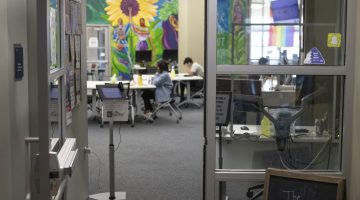Scientists, economists, sociologists and government officials of Nevada and California gathered on Saturday, Sept. 23, in the Joe Crowley Student Union for a day-long Global Climate Change Summit.
The Summit aims to start a conversation about the effects of climate change on the state of Nevada. Experts presented their research in six sessions, each exploring a different theme of climate change: science, economics, local government, industry, social impact and national defense. The public was then able to ask questions between each session.
Guest speakers highlighted gains Nevada has made in terms of reducing its carbon footprint, but they also referenced opportunities and roadblocks that lay ahead.
“How did we get to this place where our water resources are so constrained and that the Division of Water Resources is really the ‘Division of Water Litigation?” said Bradley Crowell, director of Nevada Department of Conservation and Natural Resources and keynote speaker at the summit, referencing the Division of Water Resources’ current mediating role between the Southern Nevada Water Authority and eastern Nevada residents.
Rural Nevada and Utah residents are suing SNWA over its plans to siphon groundwater from eastern Nevada valleys and pump it to drought-stricken Las Vegas.
A popular issue for the Summit crowd was Gov. Brian Sandoval’s veto this summer of a bill that would have raised Nevada’s current renewable portfolio standard goal of 25 percent by 2025 to 40 percent by 2030.
“I actually agree with the governor’s veto on that,” Crowell said. “I think it was not a rejection of the policies but recognition that that goal was premature.”
Jeanne Benedetti, a project manager at Fulcrum Bioenergy, presented the Nevada-based company’s Sierra Biofuels Plant project at the summit on Saturday. She asserted that themes from all six sessions converge into the work done at Fulcrum.
“How we are applying carbon taxes, standards, regulations, conservation of resources, planning, all goes into the development of what we’re doing: converting garbage into jet fuel,” Benedetti said to the crowd.
Phase one of the Sierra Biofuels Plant project, the feedstock processing facility, was completed in 2016. The 65,000 square foot facility is located 20 miles east of Reno in Storey County. Feedstock is garbage minus high-moisture wastes, like food and yard trimmings. The feedstock is then compounded into industrial shredders, which are fitted with magnets that remove scrap metals. The product is then transported to the biorefinery and ultimately converted into jet fuel.
The biorefinery is phase two of the Sierra project and is scheduled to open operations in 2020.
The Federal Aviation Administration is committed to a 50 percent net reduction in carbon emissions by 2050. Biofuels are pivotal in achieving that goal, and if the Fulcrum biorefinery is completed on time it will operate for 30 years prior to the FAA deadline. Benedetti alluded to further federal promotion of renewable energy.
“The Department of Defense gave us a $70 million grant to help commercialize this technology because getting the technology and the molecules of biojet in the market is offsetting the fossil,” said Benedetti.
Additionally, UNR assistant director for environmental programs, John Sagebiel, commented on companies like Tesla and Switch and the increasing prevalence of corporate renewable energy commitments.
Switch is a major data center company that powers its buildings on 100 percent renewable energy. In February 2017, it opened the largest data center in the world, at 1.3 million square feet, in Reno, Nevada.
“I think renewable energy is as much about their marketing as it is about how they actually operate,” said Sagebiel. “Ultimately, an electron is an electron whether you generate it’s renewably or not, it’s going to power your data center just as well.”
Gabriel Selbig can be reached at mpurdue@sagebrush.unr.edu and on Twitter @NevadaSagebrush.











